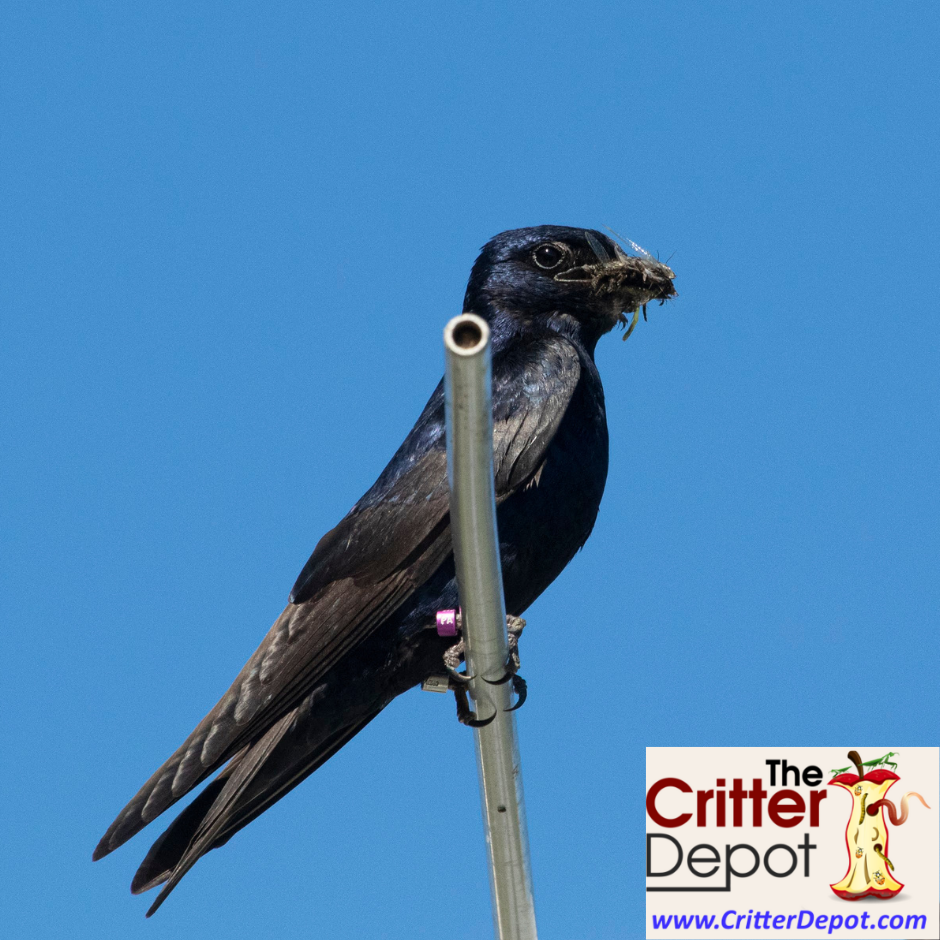Purple Martin Feeding Guide
When you’re an aerial insectivore, you usually have plenty of menu items during the spring, summer, and autumn months. But things can start to get challenging during times of inclement weather, such as cold, rain, or wind. Purple Martins are an aerial insectivore and will pick off unsuspecting insects midflight with precision and accuracy. But when the temperatures drop, so does the insect availability. This leaves the Purple Martin in a predicament, with a shortfall of nutrients.
When flying insects are scarce, energy spent foraging unsuccessfully can hasten starvation. Purple Martin landlords can be pro-active, and provide nutritional food sources for the Purple Martins during these times of inclement weather.

What to Offer Purple Martins
It’s important that Purple Martins get plenty of protein and fat in their diets. During the spring and summer months, this is relatively easy in northern areas with the abundance of bugs swarming and flying. But it’s not so easy to supply them with the fat and protein they need in times of bad weather. Crickets and superworms are a great supplement for landlords looking to assist Purple Martins and their diets.
Cricket nutrients
Crickets are a nice feeder option for Purple Martins because of their high protein content. 66% of a cricket is made from protein, which makes them a great offering for any swallow. However, their fat content is on the light side, only ranging at about 22%. If the Purple Martins are looking for a feeder with more fat, then superworms are going to be a better option. On the other hand, crickets are an insect and may be easier to offer to a picky Purple Martin.
Superworm nutrients
Superworms have much lower protein than crickets. 47% of their body composition is protein, which is pretty significant. But still shy of the hearty cricket. But their body fat is greater, ranking at 42%. If your group of birds needs a fattier offering, superworms will end up being the better option. One drawback with superworms is their appearance. They don’t look like flying insects, which may give the Purple Martin pause when trying to feed them.
How to Feed Purple Martins
Because Purple Martins are aerial predators, you’re going to need your supplemental feeders to fly! But, superworms nor crickets fly. So, you’ll have to get crafty and find a way to propel these feeder insects into the air. Some have recommended using plastic spoons. With this recommendation, place the insect inside the bowl of the spoon. Firmly hold the handle, and pull back the tip of the bowl to build tension, then let her rip! This technique should propel the feeder high enough to attract the Purple Martin.
Slingshots are another method to propel feeder insects at high altitudes. There are a variety of slingshots available on the market. And ideally, you’ll need the cricket or superworms to be launched high enough so that they arch over the Purple Martin housing. This will help catch their keen eyesight. But be mindful that you will go through a handful of insects before the martins take notice. They are not familiar with insects demonstrating artificial flight. So it will take a few times and training to get them familiar with the process. So have tapered expectations when you first start. But after they learn of this new behavior, they will have greater anticipation and be more aware.
Both crickets and superworms will need to be deceased prior to launch. Both insects (especially crickets) will be too squirmy to launch them alive. Freezing the insects is the best option. If ordering superworms or crickets online, place the package in the freezer. Wait 24 hours before you decide to launch them. This will preserve the nutritional edibility of the insects for the benefit of the Purple Martins.
Avoid letting the deceased insects sit at room temperature. Their bodies will naturally start to decompose, and can begin to fill with bacteria that can be harmful.
Calcium
It’s common for landlords to offer oyster shells for their Purple Martins. But contrary to popular practice, this extra step may prove to be unnecessary. An academic study by Ecoscience compared the health and development of Purple Martins being fed supplemental calcium, against a control group of Purple Martins that were not fed calcium. What they discovered was that there were no differences in health or development between the two groups. Suggesting that offering calcium supplements offer no extra benefits. For more information on calcium supplementation for Purple Martins, check out this academic study: https://www.jstor.org/stable/42901307
But just like inclement weather feeding, many landlords feel the need to offer calcium. Oyster shell granules can be purchased at any feed store. The popular method is offering crushed oyster shell granules in a dish and wheeling it up closer to their housing. The theory is that they will consume the oyster shells for their own health and wellness.
One method we do recommend is dusting your feeder insects with calcium powder. This is popular in the reptile community and will be a good method to offer calcium to your birds. Take the crickets or superworms, place them in a small cup, and mix in a small spoon full of calcium powder. This will coat their entire exoskeleton. Then, proceed to propel them in the sky, until the Purple Martins start to pick them off one by one.
Overall, it isn’t always necessary to offer feeding or calcium supplements to the Purple Martins. Weather can play such a large factor in the year-to-year success of the Purple Martin population, providing supplemental food can help them through challenging times and allow you to admire their beauty and grace for years to come.
Author: Critter Depot
Visit their website: https://www.thecritterdepot.com/

